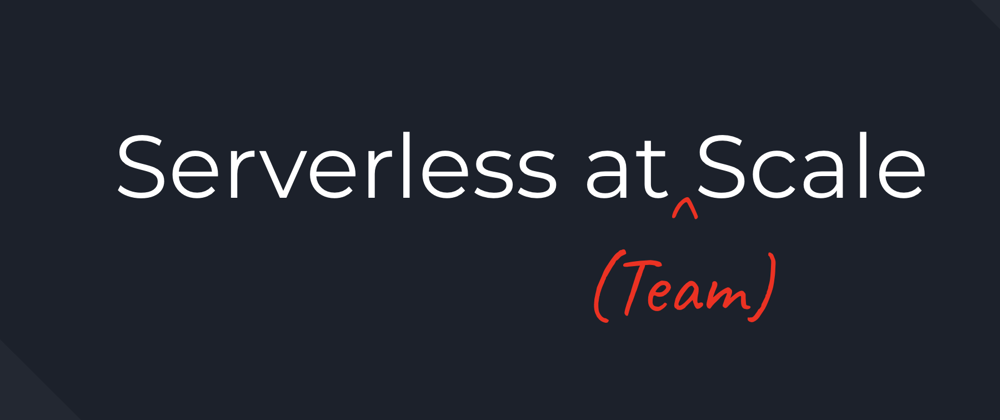One of the great aspects of building Serverless applications is that it's pretty dang easy to get started. You can plop down five lines of yaml in your framework of choice, and deploy a full endpoint comprising an API Gateway, a route, a Lambda function and trigger, IAM role and policy, AND even logging. And the best part is that it's massively scalable. You don't need to deploy a load balancer, understand how a reverse-proxy works, or learn how to set up syslog. You can just push code!
And yet somehow, so many of our serverless.yml files come out looking more like this:

CloudFormation is great! Seriously, this post is not thrashing CloudFormation. It does so much! It manages the state of the services you're configuring, it understands how to resolve dependencies between cloud pieces, and provides a reliable, deterministic way to provision infrastructure. However - As your Serverless usage ramps up, you'll often find the complexity, size, and subsequent deploy times of your applications grows very quickly.
Primarily this is due to the fact that your application consumes or provisions numerous AWS resources. This in itself is not a bad thing, the Serverless mantra is to prefer managed services over custom solutions! However, you'll often find your template(s) include a bunch of resources. When you deploy these templates CloudFormation needs to construct a directed, acyclic graph of resources, and check the configuration of each resource before moving on. This takes a long time, upwards of 20 minutes in some cases. These deployment times are challenging as the vast majority (> 90%) of your deployments will only touch the actual business configuration (Lambda function code) for your app!

As you grow, you'll also want to solve new business problems with Serverless. This leads to new stacks, and often presents an issue - how does one share infrastructure between Serverless stacks? More specifically, frequently shared infrastructure like cognito pools, VPCs, or API Gateways. You may even run into the dreaded 500 resources per CloudFormation stack error!
Although it's tempting to reach for a plugin which can split stacks into smaller stacks, that's only going to increase your deployment times (not to mention overall complexity). It's time to split stacks, but the right answer is not to split one giant stack programmatically. The answer is to split your infrastructure from your code, intentionally.
To successfully scale your Serverless teams and deployments, you need to divide infrastructure from code, use CloudFormation Outputs to share resources, and leverages SSM to keep non-CloudFormation tools like Terraform in sync.
Divide and conquer your business domains in the cloud
Specifically, split your long-lived and/or shared infrastructure from the resources you change frequently.
Frequently changed resources are generally:
- Lambda function code & configuration
- API Gateway configuration (unless you're using a shared gateway or mono-lambda pattern)
- DynamoDB table (unless it's shared, which I don't typically recommend)
Long-lived infrastructure are things like:
- Cognito configuration
- VPCs
- API Gateways (if they are shared, or you're using a mono-lambda pattern)
- EventBridge
- SNS topics
- Kinesis Producers
The key takeaway here is to move your shared, long term, slowly-changing infrastructure into a separate stack from your domain-specific, often-updated business logic & configuration. This will reduce the cognitive overhead of logic changes, limit bug blast radius, and perhaps most relevant for developers like myself - drastically cut down on deployment time. If you haven't read my post about how to cut that down even further, check out developing against the cloud
Warning signs which indicate your stacks are too large
The biggest sign you need to split your infrastructure into new stacks is if you find yourself violating the Infrastructure Law of Demeter. That is to say - the Lambda function which run your business logic are greater than one hop from the infra you provision in the same stack.
Beyond that, there are several other code smells which, when you catch a whiff, warn you it's time to split your infra from your code. Namely:
- Your serverless.yml file is greater than a few hundred-ish lines
- You've got more than a lambda function, dynamo table, and maybe a DDB stream-based function in your stack
- You're trying to decide if you should add a new business domain into a stack purely because a database table, bucket, or vpc is set up in the existing stack
A clean and scalable way to share resources between stacks is with CloudFormation Outputs. Outputs let you share arbitrary primitives across stacks within the same AWS Account. You can declare these inside your serverless.yml in the resources block:
resources:
# Okay, now we're writing raw CloudFormation
Resources:
Outputs:
PersonasTableArn:
Description: The ARN for the Persona's Table
Value:
'Fn::GetAtt': [personasTable, Arn] # This could be a string, but I'm using a GetAtt as that seems more realistic
Export:
Name: ${self:service}:${opt:stage}:PersonasTableArn # Export name must be *unique* across all outputs for a region. This name is what you'll import in other stacks
Then you'll use the Export name in another stack to consume the output with the ${cf:output_name} syntax (documentation here):
provider:
environment:
PERSONAS_TABLE_ARN: ${cf:OtherService:${opt:stage}:PersonasTableArn}
You can learn more about cross-stack references here. Here's a more detailed reference for Serverless Framework projects.
Notes on Terraform, and other non-CloudFormation systems
It's also common to reconcile Serverless with your existing IaC tools, like Terraform. If you do use Terraform, I'd recommend adhering to the same principles above. Namely, rely on Terraform to provision your long-lived, seldom-changed infrastructure. Then use SAM, Serverless Framework, or whatever you prefer for rapid code deployments.
Terraform doesn't rely on CloudFormation. Instead, it offers to store state in an plethora of backends (often an S3 bucket), which means you'll need to share resource identifiers manually, instead of using CloudFormation Outputs. The easiest option I've found is to rely on AWS Systems Manager (SSM).
If you use Terraform to provision something like a Cognito pool, or a shared SQS Queue, you'll need to publish the ARN or name into SSM using the Terraform SSM parameter resource. Then you can consume them in Serverless apps with the ${ssm:...} reference.
Occasionally you'll find yourself needing to share resources FROM a CloudFormation stack TO a Terraform project. In that case, I recommend you try the serverless-ssm-publish plugin. This will allow you to publish to SSM upon deployment of your infrastructure stacks, and then consume them in Terraform.
The downside of mixing the two, and more generally using SSM to maintain cloud state, is that there's no dependency resolution. One must be careful to ensure your Terraform projects push data to SSM before consuming them in Serverless apps, and vice-versa.
Regardless if you choose to keep your entire IaC configurations in Serverless, CloudFormation, Terraform, or anything else - beyond a certain scale, you'll want to separate infra from app logic. This will keep cognitive overhead per deployment low, limit your deployment blast radius, and cut down on that ever-important deployment time.
Interested in learning more? You can always find me on twitter







Top comments (6)
Excellent read! This is very insightful!
I have written about a similiar topic. Creating a "base-stack" for long lived resources like a VPC using the AWS CDK.
blog.phillipninan.com/insider-secr...
Thanks Phillip!
Nicely summarized. I recently did published a POC setup for apigateway -> cognito -> 2 Lambdas in Github with full documentation. Please find it here github.com/BalmanRawat/cognito-api... . It might be helpful for someone who is looking for the skeleton and basic bootstrapping templates.
Nice article, I just now stumbled upon it. I can relate to some parts definitely. Out of curiosity, how would you then deploy the infrastructure stack(s)?
Another thought, about extracting API Gateway in the case of mono-lambda, I think it could be useful to leave it in the Serverless Framework stack if you're creating actual resources on it that would then be useful for monitoring (I briefly discuss this here, feel free to share your thoughts)
Cheers
Great point on segregating long-lived, non-domain infrastructure from the resources that are more likely to change over time. Using multiple stacks and outputs has significantly helped in the past.
Thanks Alex! It's helped me too!